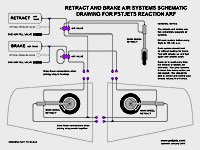 Air System Schematic Drawing for PST retracts and brakes. This is your "roadmap" to understanding
how all of the components and air lines are hooked up. You should really print this drawing (use one of
the links below) so it's handy when all those air lines start looking like a bowl of spaghetti.
Air System Schematic Drawing for PST retracts and brakes. This is your "roadmap" to understanding
how all of the components and air lines are hooked up. You should really print this drawing (use one of
the links below) so it's handy when all those air lines start looking like a bowl of spaghetti.
PDF:
Air System Schematic Drawing - PST Package
PDF:
Air System Schematic Drawing - Pro-Links Deluxe
|

|
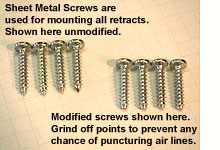 Prepare Your Mounting Screws. Sheet metal screws are provided for mounting all three retracts
because they are easier
to install than bolts and blind nuts, and they might protect the airframe by ripping out cleanly in a
rough landing (something I don't care to test!). However, the sharp points could possibly damage
air lines, so use a grinder to round them off slightly.
Prepare Your Mounting Screws. Sheet metal screws are provided for mounting all three retracts
because they are easier
to install than bolts and blind nuts, and they might protect the airframe by ripping out cleanly in a
rough landing (something I don't care to test!). However, the sharp points could possibly damage
air lines, so use a grinder to round them off slightly.
|

|
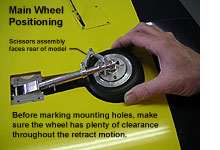 Mark the Main Wheel Retract Mounting Holes. This is a little trickier to do than it may appear
at first. If you just lay the assembly in place with the wheel centered in the wheel well, it may not
be in the ideal position. You need to move the wheel and strut up and down and watch for clearance
around the wheel as it passes through the cutout in the wing skin. When satisfied with the position,
mark the mounting holes, remove the retract, and drill at the marks with a 3/32" drill bit.
Mark the Main Wheel Retract Mounting Holes. This is a little trickier to do than it may appear
at first. If you just lay the assembly in place with the wheel centered in the wheel well, it may not
be in the ideal position. You need to move the wheel and strut up and down and watch for clearance
around the wheel as it passes through the cutout in the wing skin. When satisfied with the position,
mark the mounting holes, remove the retract, and drill at the marks with a 3/32" drill bit.
|

|
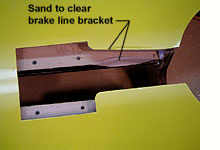 Prepare the Mounting Area. The upper "L" bracket for the brake
air line interferes with the wing skin and plywood rail, so I used a Dremel tool with a sanding drum
to provide clearance in this area.
Prepare the Mounting Area. The upper "L" bracket for the brake
air line interferes with the wing skin and plywood rail, so I used a Dremel tool with a sanding drum
to provide clearance in this area.
|

|
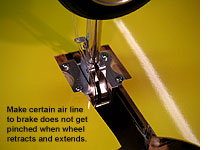 Install the Main Wheel Retracts. Thread the retract air lines through the
wing, then attach them to fittings on the side and end of the retract cylinder. Now you can slide
the retract unit in place and bolt it down with four mounting screws. Add the brake air line, then
work the retract up and down a few times by hand to make sure it stays clear at all times.
Install the Main Wheel Retracts. Thread the retract air lines through the
wing, then attach them to fittings on the side and end of the retract cylinder. Now you can slide
the retract unit in place and bolt it down with four mounting screws. Add the brake air line, then
work the retract up and down a few times by hand to make sure it stays clear at all times.
|

|
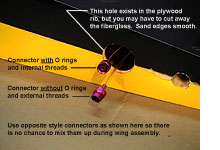 Finish the Air Lines in the Wing. Refer to the
Retract and Brake Schematic Diagram
and finish adding the "T" fittings and end connectors as shown.
Each wing panel will have two air lines coming out of the wing root, and two air lines coming
out of the upper skin through the same holes as the servo wires. I added yellow
tape strips to my brake lines at the ends to help identify them.
Finish the Air Lines in the Wing. Refer to the
Retract and Brake Schematic Diagram
and finish adding the "T" fittings and end connectors as shown.
Each wing panel will have two air lines coming out of the wing root, and two air lines coming
out of the upper skin through the same holes as the servo wires. I added yellow
tape strips to my brake lines at the ends to help identify them.
|

|
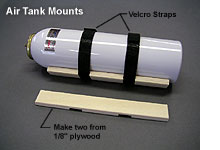 Prepare Two Air Tank Mounts. Now we move to the front fuselage section to install the nose wheel
retract, the nosewheel steering servo, and the air tanks. Materials for the air tank mounts are not
provided, so the method shown here is just a suggestion. I used two layers of 1/8" lite-ply, with
gaps in the bottom layer for the 1/2" velcro straps.
Prepare Two Air Tank Mounts. Now we move to the front fuselage section to install the nose wheel
retract, the nosewheel steering servo, and the air tanks. Materials for the air tank mounts are not
provided, so the method shown here is just a suggestion. I used two layers of 1/8" lite-ply, with
gaps in the bottom layer for the 1/2" velcro straps.
|

|
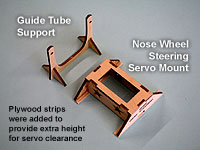 Build the Guide Tube Support and Steering Servo Mount. These plywood parts are provided with
the ARF, but they need
to be assembled and glued together using CA or epoxy. My servo was a little tall, so I added plywood
strips on the bottom to raise the mount slightly. I also added small plywood pads underneath the screw
holes at each end to provide extra thickness. Use epoxy to glue the servo mount, guide tube support,
and tank mounts to the bottom of the fuselage.
Build the Guide Tube Support and Steering Servo Mount. These plywood parts are provided with
the ARF, but they need
to be assembled and glued together using CA or epoxy. My servo was a little tall, so I added plywood
strips on the bottom to raise the mount slightly. I also added small plywood pads underneath the screw
holes at each end to provide extra thickness. Use epoxy to glue the servo mount, guide tube support,
and tank mounts to the bottom of the fuselage.
|

|
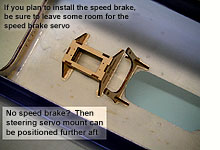 Glue Mount and Support in Place. The servo mount can be mounted further aft than shown here,
but this one was positioned as far forward as possible to leave room for a speedbrake servo
(to be installed later).
Glue Mount and Support in Place. The servo mount can be mounted further aft than shown here,
but this one was positioned as far forward as possible to leave room for a speedbrake servo
(to be installed later).
Add Nose Wheel Strut. As with the mains, work the nose strut up and down a few times
to make sure it is positioned properly before marking the mounting holes. Attach air lines to
the nose wheel retract unit, then bolt it in place.
|

|
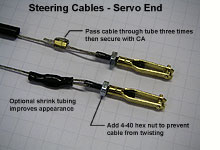 Assemble the Steering Cables, Servo End. The nose wheel uses pull-pull cables for steering.
The cables need to be guided around the wheel and strut when retracted using nylon guide tubes.
For some odd reason, the tubes are not included with the ARF - use inner nyrod tubing or something
similar. The cable and most of the hardware shown here is included
with the ARF (except for the 4-40 hex nuts and shrink tubing).
Assemble the Steering Cables, Servo End. The nose wheel uses pull-pull cables for steering.
The cables need to be guided around the wheel and strut when retracted using nylon guide tubes.
For some odd reason, the tubes are not included with the ARF - use inner nyrod tubing or something
similar. The cable and most of the hardware shown here is included
with the ARF (except for the 4-40 hex nuts and shrink tubing).
|

|
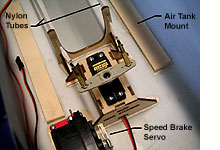 Install Steering Servo. Use a double servo arm as shown. Connect the cables to the arm, using
holes that have the same spacing as the two nylon attach points on the nose wheel strut.
Install Steering Servo. Use a double servo arm as shown. Connect the cables to the arm, using
holes that have the same spacing as the two nylon attach points on the nose wheel strut.
NOTE: Use a separate radio channel for nose wheel steering slaved to the rudder channel
(do not use a Y-connector) so that you can program the steering alone. Generally, you only need a
small amount of movement in the nose wheel, maybe 15 degrees each direction for good ground handling.
|

|
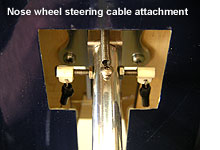 Finish the Steering Cables. For this step, be sure to have the servo plugged into the receiver
and the radio switched on so it stays centered. Working with one cable at a time, finish the ends at
the nose wheel strut as shown in the photo. The idea here is to make them as close to proper length as
possible, then adjust them at the servo end if needed. There should be no slack in the cables, but they
do not need to be banjo tight. If they are too tight, the cables could prevent the nose strut from
locking in the down position.
Finish the Steering Cables. For this step, be sure to have the servo plugged into the receiver
and the radio switched on so it stays centered. Working with one cable at a time, finish the ends at
the nose wheel strut as shown in the photo. The idea here is to make them as close to proper length as
possible, then adjust them at the servo end if needed. There should be no slack in the cables, but they
do not need to be banjo tight. If they are too tight, the cables could prevent the nose strut from
locking in the down position.
|

|
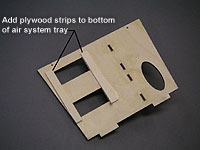 Prepare the Air System Tray. I added plywood strips as shown in the photo to the bottom of
the tray. Depending on your servos and how you intend to connect them to the valves, you may want
to add strips like this to the top of the tray to raise the servos. Plan ahead.
Prepare the Air System Tray. I added plywood strips as shown in the photo to the bottom of
the tray. Depending on your servos and how you intend to connect them to the valves, you may want
to add strips like this to the top of the tray to raise the servos. Plan ahead.
|

|
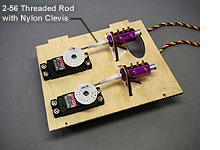 Install the Servos and Air Valves. These linkages are not provided with the ARF package.
I decided to use 2-56 threaded rods with nylon clevises, connected to the servo arms with
low-tech, but trustworthy "Z" bends. As you can see, the air valves only move about 1/4" (6 mm),
so use short servo arms and program the endpoints carefully so the servos do not stall. At this
point, either valve can be used for retracts and the other for brakes.
Install the Servos and Air Valves. These linkages are not provided with the ARF package.
I decided to use 2-56 threaded rods with nylon clevises, connected to the servo arms with
low-tech, but trustworthy "Z" bends. As you can see, the air valves only move about 1/4" (6 mm),
so use short servo arms and program the endpoints carefully so the servos do not stall. At this
point, either valve can be used for retracts and the other for brakes.
|

|
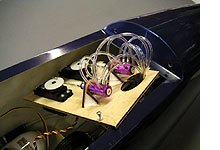 Attach the Air Lines to the Valves. As you can see, there is quite a jumble of air lines
at the valves. They will all tuck neatly under the nose, so your main concern is to avoid kinks. Route
all of the air lines down through the oval cutout in the tray and the holes in the bulkhead.
Leave enough slack in the air lines so you can pull out the plywood tray as shown in the photo.
Attach the Air Lines to the Valves. As you can see, there is quite a jumble of air lines
at the valves. They will all tuck neatly under the nose, so your main concern is to avoid kinks. Route
all of the air lines down through the oval cutout in the tray and the holes in the bulkhead.
Leave enough slack in the air lines so you can pull out the plywood tray as shown in the photo.
|

|
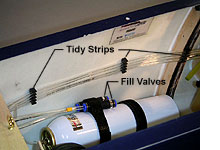 Route the Air Lines and Fill Valves. I used tidy strips inside the fuselage to keep
the air lines from flopping around. Be sure to leave your air lines
plenty long so it is easy to hook them up to the air lines coming out of the wing.
Route the Air Lines and Fill Valves. I used tidy strips inside the fuselage to keep
the air lines from flopping around. Be sure to leave your air lines
plenty long so it is easy to hook them up to the air lines coming out of the wing.
The fill valves provided with the retract system are Festo one-way valves. These work fine, but they
do not fit the air lines. The solution is to use 4mm tubing (typical turbine fuel tubing) for the fill
valves. Where the larger tubing meets the "T" fitting, use a short piece of air line on the barb,
then force the 4mm tubing over the smaller tubing. When not in use, my fill valves are secured to the
air tanks using another strip of velcro. Notice the brake fill valve is marked with yellow tape.
|